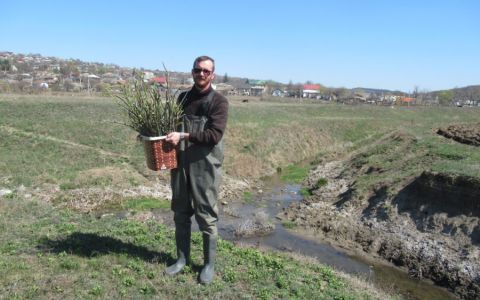Is it possible to say that a landfill is not a threat to the environment now, or will it always be a mine with delayed action in the region?
In order to solve the problem of increasing quantities of unusable and banned pesticides, in 1978 a landfill was built for their burial near the commune of Cismichioi, Vulcanesti district. During the years 1978–1988, 3,940 tons of pesticides were buried in this landfill, including 654.1 tons of DDT (dichloro diphenyl trichloro ethyl methane).
Until now, the pesticide burial ground near the Cismichioi commune is an acute and worrying ecological problem in the Republic of Moldova.
Permanent air, soil, and water quality controls are required, as well as the maintenance and improvement of the protection infrastructure of this landfill.
The polygon in Cişmichioi commune occupies an area of 2.4 ha and is located in the field, at a distance of about 10 km from the locality, its security is ensured by the employees of the State Guard.
The space of the polygon is fenced, and on the perimeter of the wall in the land afferent to the polygon, there were planted trees of the species "white acacia", thus creating a forest protection strip.
3,967 tons of pesticides are stored in the territory of the polygon in 14 sarcophagi, of which only three are arranged according to the requirements - concreted and covered with the film following laboratory investigations carried out in environmental objects such as water, soil, sludge, and biological material on in the territory of the landfill. In the period 2013–2014, the residues of seven persistent organic pollutants were detected in concentrations that exceed the maximum allowable values, some even tens of times.
As it was found after the ecological control carried out in 2016 by the Gagauzia Ecological Agency in the presence of the representatives of the Volcanic Directorate of the National Agency for Food Safety, the drainage channels arranged on the perimeter of the polygon fence is partially destroyed. Evaporation tanks are also destroyed. Some parts of the protective fence needed repair.
According to the information obtained from the Local Public Authorities and the territorial Public Health Centers, there is an increased number of cases of cancer, cirrhosis, etc.
In 2017, a group of Czech experts conducted a feasibility study on the pesticide site for the safe management of the territory, proposing the isolation of landfills and contaminated adjacent soil.
In 2020, with the financial support of the Czech Development Agency and implemented by DEKONTA, a project to bury unusable pesticides was carried out.
Regardless of the measures taken for the conservation of pesticides in Cismichioi, the locals are worried that these pesticides will produce even more negative effects in the future.
http://www.akademos.asm.md/files/Akademos_2__2017_web_compressed.pdf
http://www.infotag.md/rebelion-ro/288004/
https://nokta.md/video-mogilnik-yadohimikatov-v-chishmikioj-ugrozhaet-li-on-ekologii-i-zdorovju-zhitelej/






